Assessing the exact number of plays performed is exceptionally
difficult because of the fire that beset the musical archives of
San Giacomo during the black-letter night of September 13th, 1943.
We can only rely on the archives of Corfu and on librettos that
have been saved by various individual bodies, as well as certain
catalogues prior to the catastrophe. Opera was first performed
at San Giacomo in 1733 by a theatre company brought by impresario
Carlo Grassi and, according to evidence, the opera was “Hierone
Tiranno di Siracusa” by Bernardo Sabadini. There is also evidence
that by the end of the 18th century plays of Galuppi, Robuschi,
Anfossi, Cimarosa e.t.c. were performed.
In the 19th century, after the establishment of European peace,
the English patrons ensured especially for Corfu, the capital of
the Ionian state, conditions for growth. Since then, there is constant
presence of foreign opera companies for the entertainment of the
Corfians. The encouragement for emigration and permanent settling
of Italian music masters familiarized the residents with music,
both instrumental and vocal. During the 19th century, works of
the greatest European composers were performed at San Giacomo of
Corfu: Rossini, Mercadante, Donizetti, Bellini, Ricci, Meyerbeer,
Verdi, Pedroti, Gounot, Massenet and many others. More than 200
operas were performed in Corfu, either in the year of their composing
or few years after their first performance in European theatres,
rendering Corfu the city par excellence of Greece when it came
opera activity and San Giacomo one of the “Piu importanti” theatres
in Europe. The audience of Corfu applauded, among others, the famous
operas:
Rigoletto, Trovatore, Traviata, Ernani, Nabuco, La
Forza del Destino, I Lombardi, Otello, Luisa Miller, Lucia di Lammermoor,
I Due Foscari, Un Ballo in Maschera, Il Barbiere di Siviglia, Semiramide,
Norma, Don Pasquale, La Straniera, La Sonnambula, L’ Elisir d’Amore,
Faust, Manon e.t.c.
However, operas of Greek composers were performed very soon. In
1815, the one-act comic opera
Don Crepuscolo was performed. It
was the first opera written by a Greek composer, Nikolaos Halikiopoulos
Mantzaros, in an Italian libretto. In 1818, Stephen Poyagos’s composition
for the ballet
Arrival of Ulysses at the Phaeacians, with Greek
lyrics by poet George Rikes, was put on at San Giacomo. Other operas
followed, composed by Paolo Carrer, Domenico Padovani, Edward Labelet,
Spiros Ksindas, D.S. Rodotheatos and the celebrated composer Spiros
Philiskos Samaras, one of the most significant composers of his
day.
Almost all the orchestras, which accompanied the opera, consisted
of Corfian musicians, especially after 1840, when the Philharmonic
Society of Corfu was established. The band of Corfian opera singers
who took part in the performances supplementing the Italian theatre
companies also had special musical education.
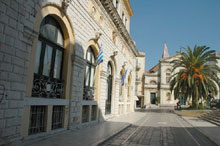 |
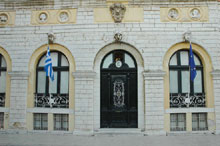 |
| At the San Giacomo theatre
today |
| |
Premières
The majority of operas composed by Greek and foreign composers
performed at San Giacomo are Pan-Hellenic firsts. In 1887, the
première of the first Greek opera
The Parliamentary Candidate by
Spiros Ksindas with Greek libretto by J. Rinopoulos, took place
at San Giacomo. The contributors were solely Corfians. It had a
local colour and was met with great success. In 1889 it was the
Pan-Hellenic first performance of the well-known opera by Spiros
Samaras,
Flora Mirabilis. It had been performed at The Teatro
alla Scala in Milan as
well, with the composer himself leading the orchestra and being
met with frantic applause.
Particular incidents at San Giacomo
In 1833, while king Othon was heading for Nafplio, he stayed in
Corfu for a few days. Commissioner Lord Nugent accompanied him
to the theatre in order
for him to attend the performance “amidst ineffable joy of Greek hearts and
souls”.
Helena Angres
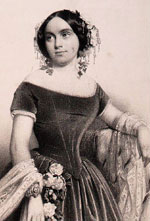
The
astonishing Corfian colorature mezzo-soprano Helena Angres (1824-1886) rose
to eminence during the 19
th century. Thanks to her exceptional
voice she triumphed in Vienna, Saint
Petersburg, the U.S.A and The Teatro alla Scala in Milan.
In May 1848 the Eparch (Mayor) of Corfu invited her to Corfu where the artist,
already “Official Singer of the Imperial Court of Vienna”, was honoured by
the Eparch and the rest of the local authorities. The artist, feeling touched,
offered to give a performance at San Giacomo and box-office revenues were
given to the poor. The manifestations of the audience were so warm that she
stated: “… I confess without hesitation that on no other occasion had I felt
such ineffable excitement as when I was applauded in the land where I saw
the light”.
The opera
Lucia di Lammermoor by Donizetti was presented in a first worldwide
performance, in the form of concertante, at San Giacomo of Corfu and then at
San Carlo of Naples as an opera performance, in 1835. Later it was repeatedly
performed in Corfu where it met with great success.
After being performed for the first time in Italy under the tilte
Nabucodonosor (1842),
Nabuco,
the marvelous opera by G. Verdi, was presented at San Giacomo in 1844. The Corfians
though, not being able to pronounce the lengthy name of the Babylonian emperor,
abbreviated it to Nabuco. Thus, abbreviated after the Corfian performance, the
title “Nabuco” prevailed worldwide and officially. This elated the composer who
was affiliated to Corfu, since he himself, like Puccini, used to come to the
island incognito for a holiday.
It is still a fact that in Corfu of the 19
th century the melody offered
by Italian opera was appreciated and the Corfians fashioned extreme sensibility
in their association to music and critical competence in pursuit of perfection.
Not only the upper class members and the wealthy but also wage earners had the
above traits. Wage earners in particular were willing to go to bed fasting rather
than miss even a single opera. Tradition has preserved stories of passionate
music lovers who, on the nights of the performances, filled the streets around
the theatre and defied rain and winter cold in order for their ears to capture,
in respectful silence, the notes which intoxicated them. In deference of the
general mystagogue, the cabbies avoided going by the street of Cale delle acque
that was passing by San Giacomo.
Because of the musical education of the Corfians, San Giacomo became a “musical
rank” where the worth of every new artist was tested. The enviable title “Applauditi
Corfu” (I was applauded in Corfu) was a passport for the artist who had aspirations
of performing in great Italian theatres of the time.
During the 19
th century those beyond the Adriatic Sea considered Corfu
a geographical ground of Western Europe and San Giacomo “a borderline centre
of musical mystagogy via the opera”, important according to the large claims
of the local intelligenzia. The above point of view was accepted by all historians
and the specific title was extremely complimentary.
After the performances at San Giacomo ceased and the theatre was turned into
a Town Hall, the music loving audience of Corfu, carrying a great musical tradition,
found shelter in the new Municipal Theatre, which would meet, even for a shorter
period, new days of glory. [Original text in Greek taken from the web site of
the Municipality Corfu:
http://www.corfu.gr/en.htm .]
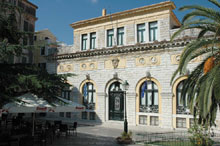 |
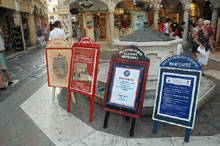 |
| San Giacomo theatre was built at the end
of the 17th century. Today it houses the Town Hall |
The philharmonic orchestras of the city are numerous. The phenomenon is unique in Greece. |
| |
Nowadays, in the whole course of the year and particularly in the
summer, Corfu organises cultural events that involve a wide range
of arts. Painting exhibitions, thematic exhibitions, theatre performances
and concerts take place at the New Fortress, the Old Fortress,
Mon Repos and other venues.
For more information on cultural events in Corfu please visit:
http://corfuland.gr/index.php?option=content&task=view&id=237&Itemid=74
http://www.corfu.gr
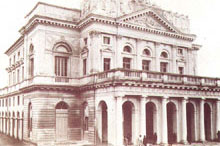 |
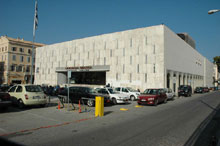 |
| The Municipal Theatre of Corfu was built
in 1903 and was destroyed in 1943 during the German bombardment
of World War II |
Today’s theatre |
| |
 |
 |
 |
| The old fortress... |
...the new fortress... |
...and Mon Repos theatre are some of the sites where cultural events take place during the summer. |
| |